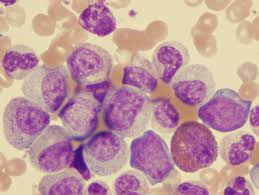 Leukemia is a type of cancer that starts in the bone marrow, which is the soft tissue in bone is responsible for producing red blood cells, white blood cells, and platelets. Some cells can change into the leukemia cells, which then become more healthy dividing cells. For cancer of the bone marrow create more leukemia cells, healthy cells pushing them out and replace them, making it difficult for blood to function properly, and that leads to serious medical problems. There are four main types of leukemia into two categories depending on how leukemia in progress and the difference between normal and abnormal cells.
Leukemia is a type of cancer that starts in the bone marrow, which is the soft tissue in bone is responsible for producing red blood cells, white blood cells, and platelets. Some cells can change into the leukemia cells, which then become more healthy dividing cells. For cancer of the bone marrow create more leukemia cells, healthy cells pushing them out and replace them, making it difficult for blood to function properly, and that leads to serious medical problems. There are four main types of leukemia into two categories depending on how leukemia in progress and the difference between normal and abnormal cells.Acute leukemia
 Acute myelogenous leukemia (AML) is cancer that spreads rapidly in the blood and bone marrow. Because the original leukemic cells, bone marrow that produces a variety of blasts, or not, nonfunctional cells. Under healthy circumstances, these cells will develop into white blood cells that fight infection, red blood cells carry oxygen throughout the body, or platelets to help clotting. However, in people with AML, these blasts do not experience normal development and inhibits the production of new cells.
Acute myelogenous leukemia (AML) is cancer that spreads rapidly in the blood and bone marrow. Because the original leukemic cells, bone marrow that produces a variety of blasts, or not, nonfunctional cells. Under healthy circumstances, these cells will develop into white blood cells that fight infection, red blood cells carry oxygen throughout the body, or platelets to help clotting. However, in people with AML, these blasts do not experience normal development and inhibits the production of new cells.Acute lymphocytic leukemias (ALL) is a cancer that is similar to acute myelogenous leukemia exception, rather than affecting all cell types, beginning in lymphocytes. Lymphocytes are white blood cells that defend the body against infection. Bone marrow makes cells has not been known as the blasts, which in healthy people will become lymphocytes. ALL the people, however, does not blasts develop into white blood cells normally. Abnormal cells that later took place in the mind is usually devoted to healthy cells, and inhibit the creation of new cells. This process can lead to a reduction of red blood cells and the development of anemia, as well as a reduction of white blood cells that leads to a weak immune system.
Chronic Leukemia
 Chronic lymphocytic leukemia (CLL), such as the type of leukemia, developing in the blood and bone marrow. Chronic leukemia take place at the slow rate of acute leukemia, but still affects the lymphocytes, which normally fight infection. CLL made too many nonfunctional lymphocytes that takes the place of healthy cells. As cancer cells continue to multiply, they inhibit the functional effectiveness of lymphocytes, leading to a weak immune system. Slow healing and anemia can also occur in CLL patients as red blood cells and platelets are replaced by abnormal lymphocytes.
Chronic lymphocytic leukemia (CLL), such as the type of leukemia, developing in the blood and bone marrow. Chronic leukemia take place at the slow rate of acute leukemia, but still affects the lymphocytes, which normally fight infection. CLL made too many nonfunctional lymphocytes that takes the place of healthy cells. As cancer cells continue to multiply, they inhibit the functional effectiveness of lymphocytes, leading to a weak immune system. Slow healing and anemia can also occur in CLL patients as red blood cells and platelets are replaced by abnormal lymphocytes.Chronic Myeloid leukemia (CML) is a slow-growing type of leukemia that makes almost-functional marrow red blood cells, white and platelets-in disproportionate numbers. Many of the white blood cells and platelets are made, while the number of red blood cells formed. Blood flow begins to slow as the number of white blood cells increased and the patient may experience severe anemia due to a decrease in red blood cells.
The symptoms vary for each type of leukemia, but common symptoms include fever and chills, fatigue, frequent infections, loss of appetite and weight, swollen lymph nodes, easy bruising or bleeding, shortness of breath, bone pain, night sweats, and bleeding into the skin.
Complete blood count, or CBC, is a blood test that measures the count of red blood cells, white blood cell count, hemoglobin level and platelet count, among others. It is commonly used to diagnose leukemia. Another method used for diagnosing leukemia including marrow biopsies, spinal fluid tests, physical exams, screenings chromosomes, and chest X-rays.
Treatment for leukemia may include chemotherapy, radiation, biological therapy, targeted therapies such as kinase inhibitors, and bone marrow and stem-cell transplantations.
 5:57 AM
5:57 AM
 Ronald Setiawan
Ronald Setiawan

 Posted in:
Posted in:
0 komentar:
Post a Comment